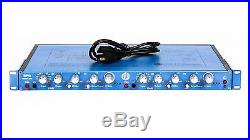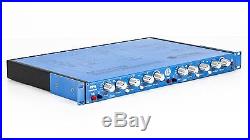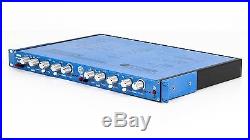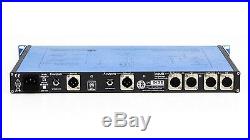AEA RPQ 2-Channnel Microphone Preamp Stereo Mic Pre U074193





This used AEA RPQ 2-Channel Ribbon Mic Preamp comes with a Power Cable. Condition: This preamp is in good condition with normal wear, has been fully tested, and sounds great! Please see pictures for details on item condition. Product Details: The AEA RPQ Ribbon Preamp with Curve-Shaping provides two channels of high-quality, high-gain, low-noise microphone preamplification, and unlike the TRP, provides phantom power for active electronics.
Building on the success of AEA's TRP ("The Ribbon Pre"), we engineered a recording toolkit packed full of professional solutions for your recording needs. Particularly well-suited for use with ribbon microphones, it delivers the speed, precision, quietness, and headroom needed for today's high-resolution recordings. The NoLoad input impedance above 10 k means the RPQ won't load down a mic and change its sound. The JFET circuit design generates up to 80 dB of clean and quiet gain, with extended bandwidth from below 1 Hz to beyond 200 kHz, for dynamic range and transient response that complements all microphones. Engineers have discovered that the RPQ also complements their moving coil, tube and solid-state mics.
By virtue of its sonic qualities and versatility, the AEA RPQ is the tool of choice for all microphones whenever a true and pristine signal path is desired. Your Sound At Your Fingertips - With mixing consoles disappearing from control rooms, dedicated preamps can take on the role of providing a high-quality front end, giving you intuitive control to make critical decisions during tracking rather than "fixing it in the mix". The RPQ's CurveShaperTM EQ gives you the tools to control your ribbons right at the start of the signal path. Switchable and tunable low frequency (LF) and high frequency (HF) controls allow you to tame proximity problems and provide HF extension and slope control.
The high-frequency CurveShaperT excels at adding a touch of air or presence, and the low-frequency control easily removes boxiness and boominess in a fast and unobtrusive way. Ribbon mics are capable of delivering strong subwoofer lows, and can have a significant bass proximity effect.
Such strong low-frequency content can mask high-frequency intelligibility, so the tunable LF filter was engineered to tame low-frequency energy to appropriate levels. Its -20 dB shelving curve is ideally suited to reduce excessive proximity effect, opening up new possibilities to use ribbon mics in close-up applications. The HF filter enables you to extend the high end by adding a little extra presence or "air" to a recording. Its unique bell curve compensates for the high-frequency roll-off that is inherent to most ribbon microphones. But beyond ribbon mics, the smooth HF filter is remarkably well suited for brightening up condenser mics used at a distance or even as a clean and transparent high-frequency boost on the 2-bus to freshen up a mix. The Impedance Matching Myth - Passive microphones like ribbons and moving-coil transducers interact with the input impedance of the preamp. If the impedance of the preamp is too low, the microphone will have to work harder to send a signal down the line. Additionally, the bandwidth (particularly in the low end) will be limited. For best voltage transfer, the impedance of the preamp should be at least five times the microphone's output impedance. Many microphones have a nominal impedance of about 200 Ohms, leading to the assumption that a preamp impedance of 1.0 to 1.5K Ohms should be fine. However, passive microphones, and ribbons, in particular, have an output impedance that rises towards low frequencies and can easily get as high as 1000 Ohms at resonance, resulting in a 6 dB loss at this frequency with a low impedance preamp. A preamp impedance of significantly more than the commonly seen 1.0 to 1.5K Ohms is beneficial for all passive ribbons and moving-coil microphones. All AEA preamps have input impedances of at least 10K Ohms for these reasons. Microphone loading because of low impedance preamps can lead to interesting creative results, but AEA's NoLoad inputs will guarantee highest sensitivity and bandwidth in all situations. Two channels with 80 dB of sweet and quiet JFET gain for all mics. AC (phantom power) and DC coupled (no phantom) inputs.T EQ and low frequency proximity control. Switchable phantom power, polarity and EQ. These are pictures of the actual product you will receive. Don't forget the cables! Find the professional cables you need.
Pixel Pro Audio is a retail store based in Appleton, Wisconsin with a passion for professional audio and studio recording. Not sure what you need? Your #1 Source for New and Used Recording Gear! The item "AEA RPQ 2-Channnel Microphone Preamp Stereo Mic Pre U074193" is in sale since Monday, March 27, 2017. This item is in the category "Musical Instruments & Gear\Pro Audio Equipment\Preamps & Channel Strips". The seller is "pixelproaudio" and is located in Appleton, Wisconsin. This item can be shipped to North, South, or Latin America, all countries in Europe, Australia, Japan, China, South Korea, Indonesia, Taiwan, Thailand, Hong Kong, Israel, New Zealand, Singapore, Saudi arabia, United arab emirates, Qatar, Kuwait, Bahrain, Malaysia.
- MPN: RPQ2
- Brand: AEA
- Number of Channels: 2
- Type: Microphone Preamp
